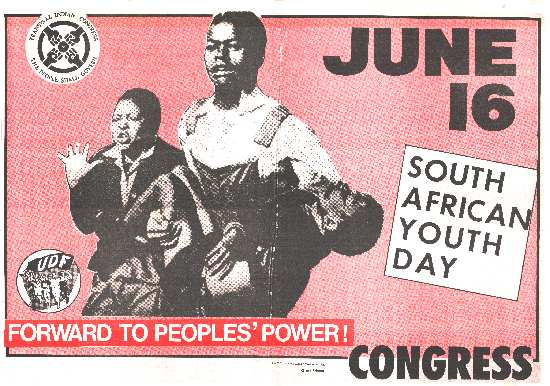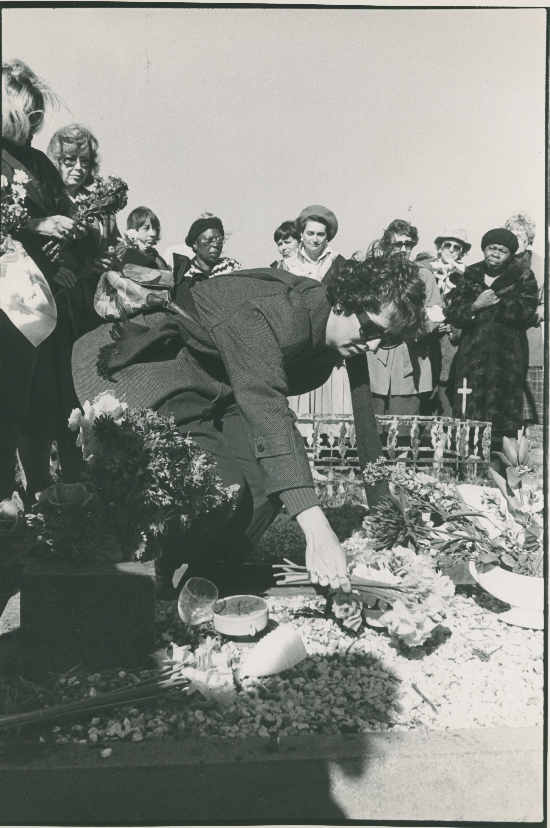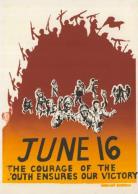Youth Day is held each year as a reminder of the Soweto Uprising and the sacrifices made by South African youth fighting for their right to education. By the mid-1970s, high school students were increasingly frustrated with Bantu Education, which had been implemented through the Bantu Education Act of 1953. The Afrikaans Medium Decree of 1974, which was to be implemented from the beginning of the 1975 school year, forced schools to provide instruction in both Afrikaans and English.
Politicised students, heavily influenced by the Black Consciousness Movement (BCM), channeled their opposition to the apartheid state by fighting for their right to a decent education, including the medium of instruction. Student leaders included Hastings Ndlovu, the first student to be killed during the Uprising, as well Murphy Morobe, who went on to become a leader of the United Democratic Front (UDF). Morobe later argued that the struggle for education opened up many to the significance of establishing a new democracy:
"...from 1976 onward... one started grappling with education questions... you start questioning what sort of education do you want - and you look at white education and you realize that in fact what whites are getting is not what we want but whites also stand to gain by democratizing our country... they too will benefit from liberation because their education will improve."
- Interview with Murphy Morobe, Cheryl Carolus and Mohammed Vally, UDF National Executive, AL2460_A13.40.1, Julie Frederikse Collection
Another leader of the Soweto Uprising w as Teboho ‘Tsietsi' Mashinini, a Morris Isaacson High School student and president of the newly formed students' Action Committee - later known as the Soweto Students' Representative Council (SSRC). He had originally proposed meeting on 13 June to coordinate a mass rally for 16 June, the day students were set to begin mid-year examinations. He had emphasized discipline and non-violent protest, but confrontation with police on the day led to numerous casualties.
as Teboho ‘Tsietsi' Mashinini, a Morris Isaacson High School student and president of the newly formed students' Action Committee - later known as the Soweto Students' Representative Council (SSRC). He had originally proposed meeting on 13 June to coordinate a mass rally for 16 June, the day students were set to begin mid-year examinations. He had emphasized discipline and non-violent protest, but confrontation with police on the day led to numerous casualties.
Over 600 young people died and over 1000 were injured during this time. Moral outrage elicited violent responses in townships throughout South Africa, including Alexandra, Thembisa, Katlehong, Vosloorus and Thokoza. Over the course of the next decade, organised youth resistance helped instigate the mounting instability that would ultimately contribute to the dissolution of the apartheid regime.
SAHA and the Soweto Uprisings
AL3285 :: Department of Education Nkosi Albert Luthuli Young Historians' Competition Collection
This collection features portfolios of learners and educators who participated in the oral history competition run annually by the Department of Education since 2006. There are several interviews conducted by learners with individuals who participated in the nationwide uprisings, including ‘unsung hero', The World journalist Sam Nzima.
AL2418 :: The Progressive Teachers' League Collection
The education crisis and ineffectiveness of the Teachers' Association of South Africa (TASA) led to the formation of the Progressive Teachers League (PTL) in 1986 under the repressive conditions of the State of Emergency. It reflects the increasing militancy of teacher organisations and the impact of the Education crisis during this period.
AL2460 :: The Julie Frederikse Collection
The transcript of SSRC student leader Murphy Morobe's interview can be found in this collection, alongsi

de audiotapes, CDs and transcripts of the oral interviews she and other people conducted over the period 1979-1990. The interviews resulted from the research done for the 1986 book "South Africa: A Different Kind of War: from Soweto to Pretoria."
AL3282 :: The Sunday Times Heritage Project (STHP) Collection
The Sunday Times Heritage Project (STHP) collection includes a wide range of material collected toward the Sunday Times newspaper’s Heritage Project. The STHP was completed in collaboration with the South African History Archives, and released during the newspaper’s centenary celebrations. As part of the project, a memorial was created in the name of Tsietsi Mashinini by Soweto-born artist Johannes Phokela. It consists of a montage tracing the route of the 1976 march superimposed on a wall, and stands in the park opposite Mashinini's old school, Morris Isaacson High School, where the protest had started, under his leadership.
Visit the Sunday Times Heritage Project (STHP) memorial to Tsietsi Mashinini.
AL2547 :: The SAHA Original Photograph Collection
SAHA's photograph collection contains numerous images related to the Soweto Uprising, as well as subsequent commemorations. Photographers include Mike Mzileni, Peter Magubane, Sam Nzima - who took the famous Hector Pieterson photo - Santu Mofokeng, Paul Weinberg, and Wendy Schweggman.





 as Teboho ‘Tsietsi' Mashinini, a Morris Isaacson High School student and president of the newly formed students' Action Committee - later known as the Soweto Students' Representative Council (SSRC). He had originally proposed meeting on 13 June to coordinate a mass rally for 16 June, the day students were set to begin mid-year examinations. He had emphasized discipline and non-violent protest, but confrontation with police on the day led to numerous casualties.
as Teboho ‘Tsietsi' Mashinini, a Morris Isaacson High School student and president of the newly formed students' Action Committee - later known as the Soweto Students' Representative Council (SSRC). He had originally proposed meeting on 13 June to coordinate a mass rally for 16 June, the day students were set to begin mid-year examinations. He had emphasized discipline and non-violent protest, but confrontation with police on the day led to numerous casualties.


